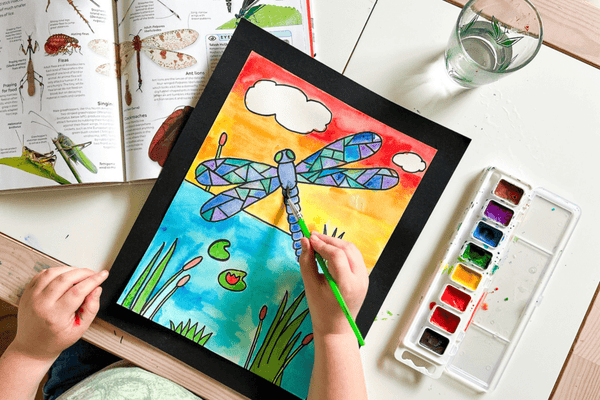
How to Teach Art in Your Homeschool (No Artistic Talent Required)
|
|
Let’s just say it out loud: not every homeschooling parent feels confident teaching art. Maybe you’re great at math or you read aloud like a one-person theater troupe—but when it comes to drawing or painting, you freeze.
If you’ve ever thought, “I can’t even draw a stick figure, how am I supposed to teach art?”—you’re not alone.
The good news? You don’t need to be an artist to teach art at home. You don’t need to be able to shade a sphere or explain the golden ratio. What you do need is a willingness to let your kids explore, create, and get a little messy.
Let’s break down how to make art a meaningful (and fun!) part of your homeschool—even if you’re “not artistic.”
Table of Contents
Teaching art doesn’t have to mean giving a lecture about color theory or leading a step-by-step drawing every week. In fact, the best art learning happens when kids have the space to:
Try new materials
Express themselves visually
Make mistakes and try again
Follow their own ideas
Your job? Create the environment where that’s possible. Set out the supplies. Offer prompts or themes. Join in when you can. Encourage their ideas. That’s it.
The goal of teaching art at home isn’t to raise the next Picasso. It’s to help kids:
Explore their creativity
Feel confident expressing ideas visually
Learn that art isn’t about perfection—it’s about process
And guess what? Kids don’t care if your trees look like lollipops! What matters to them is that you’re making space for them to create—and to be present in their efforts.
If you’re not sure how to begin, here are five low-pressure ways how to teach art in your homeschool—no talent required.
Skip the complicated projects and just set out materials. A few ideas:
Watercolor paints + paper
Oil pastels + black paper
Washable markers + coffee filters + spray bottles
Modeling clay or homemade salt dough
Glue, scissors, and a bin of collage scraps
Tell your kids: “See what you can create.” You’ll be amazed at what they come up with.
You don’t have to plan a whole lesson—just read together and see where the creativity flows. Try:
Beautiful Oops by Barney Saltzberg
Henri’s Scissors by Jeanette Winter
You can follow up with a related activity, like cutting shapes from painted paper, experimenting with “oops” art, or trying a project in the artist’s style.
There are plenty of kid-friendly drawing videos online (like Art for Kids Hub on YouTube) that walk you through fun step-by-step projects.
The key? Make it about the experience, not the result. Sit beside your child, do it with them, and model that it’s okay to “mess up” or change it.
This is a great way to ease into art if you’re feeling unsure about where to begin.
Art doesn’t have to be a totally separate subject. Try adding it to:
Science: Draw insect parts, create a life cycle wheel, or paint the night sky
Social studies: Make cultural crafts, cave paintings, or monument models
Literature: Illustrate a scene from a story, design a book cover, or make a puppet of a character
This is exactly what we do with Knowledge Crates—blend art right into unit study themes so it fits naturally into what you’re already teaching.
Sometimes, the best art projects happen when you let your child take the reins. Give them a “challenge” like:
Build something out of recycled materials
Create a sculpture using only paper
Make your own paintbrush and see what it does
You’re not directing—you’re facilitating. And you don’t have to be the expert. You just need to show up and make space for the creativity to unfold.
Here’s the secret: you don’t have to know the answer. Try one of these instead:
“Let’s figure it out together.”
“I’m not sure, but let’s try and see what happens.”
“What do you think would work?”
You’re modeling creative thinking—and showing your child that it’s okay not to have all the answers. That’s a powerful lesson all on its own.
If you’re documenting for portfolios or tracking subjects, here are just a few things that absolutely count as art:
Drawing, painting, or sculpting
Crafting with seasonal or cultural themes
Watching and responding to an art video
Creating nature collages or land art
Making art based on a story or topic you’re studying
Exploring texture, shape, and line with new materials
And yes—even scribbling with markers or molding playdough can count, especially in the early years. The key is giving it time and space in your week.
Still don’t think you’re cut out to teach art? Try this:
Think of the last time you doodled, decorated a birthday cake, picked colors for a room, or arranged flowers in a vase. That’s all creativity.
Art doesn’t have to be formal to be meaningful. It just needs to be part of your family’s life—and homeschool is the perfect place to let it grow. 🌱
You don’t need to overhaul your homeschool schedule to add art. Try:
“Maker Mondays” where kids choose an art activity to start the week
Quiet art time during read-alouds or audiobooks
A weekly art + nature walk with sketchbooks
Rotating supplies on your dining table for creative play
Or try a hands-on, open-and-go solution like Knowledge Crates, where art is already built into the learning—no planning needed.
At the end of the day, teaching art at home isn’t about talent. It’s about giving your child the tools, space, and encouragement to explore their creativity.
So pull out the paint. Pass the glue sticks. Doodle beside your child. Even if you can’t draw a stick figure, you can still create something beautiful—together.
Products Featured In This Blog